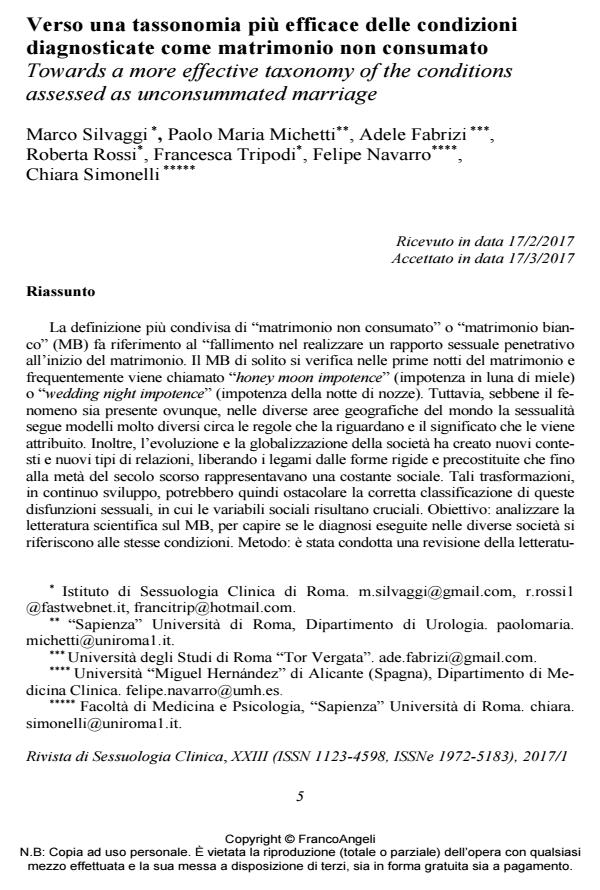Verso una tassonomia più efficace delle condizioni diagnosticate come matrimonio non consumato
Titolo Rivista RIVISTA DI SESSUOLOGIA CLINICA
Autori/Curatori Marco Silvaggi, Paolo Maria Michetti, Adele Fabrizi, Roberta Rossi, Francesca Tripodi, Felipe Navarro, Chiara Simonelli
Anno di pubblicazione 2017 Fascicolo 2017/1
Lingua Italiano Numero pagine 19 P. 5-23 Dimensione file 430 KB
DOI 10.3280/RSC2017-001001
Il DOI è il codice a barre della proprietà intellettuale: per saperne di più
clicca qui
Qui sotto puoi vedere in anteprima la prima pagina di questo articolo.
Se questo articolo ti interessa, lo puoi acquistare (e scaricare in formato pdf) seguendo le facili indicazioni per acquistare il download credit. Acquista Download Credits per scaricare questo Articolo in formato PDF

FrancoAngeli è membro della Publishers International Linking Association, Inc (PILA)associazione indipendente e non profit per facilitare (attraverso i servizi tecnologici implementati da CrossRef.org) l’accesso degli studiosi ai contenuti digitali nelle pubblicazioni professionali e scientifiche
La definizione più condivisa di "matrimonio non consumato" o "matrimonio bianco" (MB) fa riferimento al "fallimento nel realizzare un rapporto sessuale penetrativo all’inizio del matrimonio". Il MB di solito si verifica nelle prime notti del matrimonio e frequentemente viene chiamato "honey moon impotence" (impotenza in luna di miele) o "wedding night impotence" (impotenza della notte di nozze). Tuttavia, sebbene il fenomeno sia presente ovunque, nelle diverse aree geografiche del mondo la sessualità segue modelli molto diversi circa le regole che la riguardano e il significato che le viene attribuito. Inoltre, l’evoluzione e la globalizzazione della società ha creato nuovi contesti e nuovi tipi di relazioni, libe-rando i legami dalle forme rigide e precostituite che fino alla metà del secolo scorso rappresentavano una costante sociale. Tali trasformazioni, in continuo sviluppo, potrebbero quindi ostacolare la corretta classificazione di queste disfunzioni sessuali, in cui le variabili sociali risultano cruciali. Obiettivo: analizzare la letteratura scientifica sul MB, per capire se le diagnosi eseguite nelle diverse società si riferiscono alle stesse condizioni. Metodo: è stata condotta una revisione della letteratura pubblicata sul MB dal 1970 ad oggi attraverso i principali database scientifici, Pubmed Psycharticle e Psychinfo. Risultati: differenze sostanziali sono emerse fra le società medio orientali e le società occidentali. In primo luogo, nelle società medio orientali la sessualità è ammissibile solo nel matrimonio, mentre nelle società occidentali la sessualità e le relazioni non sono fortemente legate. Ciò potrebbe suggerire che il termine "matrimonio" non sia adeguato a descrivere tale fenomeno nelle diverse aree geografiche del mondo. Inoltre, il tempo medio prima della consultazione, l’attribuzione causale e la prevalenza sono molto diverse nei paesi occidentali e mediorientali. Conclusioni: abbiamo trovato che il termine "disfunzione nei primi tentativi di coito" sarebbe più adatto a descrivere le difficoltà maschili, femminili o di entrambi legate all’ignoranza sulla sessualità e all’ansia da prestazione. Mentre, oltre la categorizzazione delle disfunzioni sessuali individuali, suggeriamo il termine "Relazione non consumata" nei casi in cui pregresse difficoltà individuali verso la sessualità, sono coinvolte nella creazione di una disfunzione sessuale di coppia.
Parole chiave:Matrimonio non consumato, impotenza in luna di miele, matrimo-nio bianco, vaginismo, infertilità.
Marco Silvaggi, Paolo Maria Michetti, Adele Fabrizi, Roberta Rossi, Francesca Tripodi, Felipe Navarro, Chiara Simonelli, Verso una tassonomia più efficace delle condizioni diagnosticate come matrimonio non consumato in "RIVISTA DI SESSUOLOGIA CLINICA" 1/2017, pp 5-23, DOI: 10.3280/RSC2017-001001